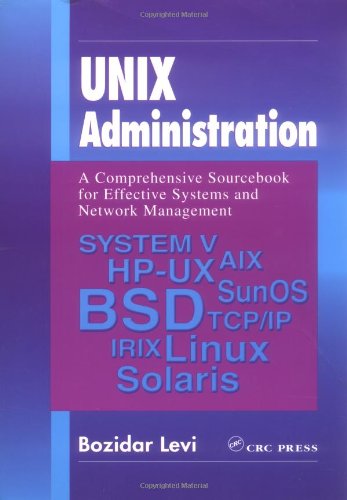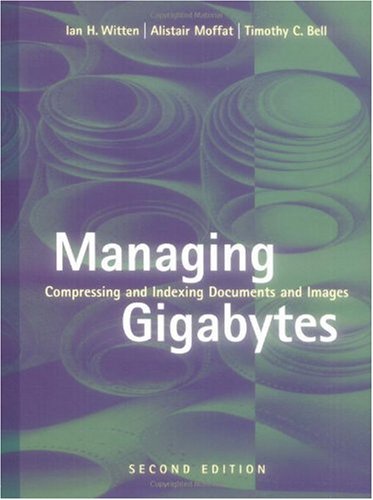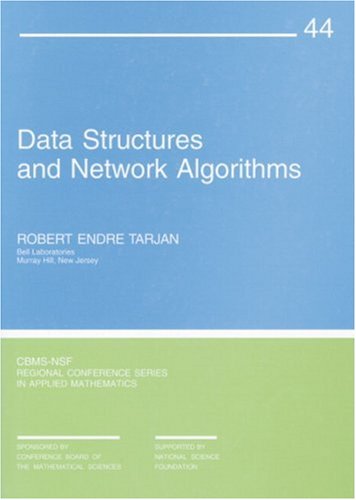Bozidar Levi0849313511, 9780849313516, 9781420000030
Table of contents :
Cover……Page 1
Table of Contents……Page 2
UNIX Administration.A Comprehensive Sourcebook for Effective Systems and Network Management……Page 12
Preface……Page 14
BookmarkTitle:……Page 17
1.1 UNIX Operating System……Page 18
1.2 User’s View of UNIX……Page 20
1.3.1 Berkeley Standard Distribution Š BSD UNIX……Page 21
1.3.2 System V or ATT UNIX……Page 22
1.4 UNIX System and Network Administration……Page 26
1.4.1 System Administrator’s Job……Page 27
1.4.2 Computing Policies……Page 30
1.4.3 Administration Guidelines……Page 33
1.4.4 In This Book……Page 39
2.2 Files……Page 41
2.2.1 File Ownership……Page 42
2.2.2 File Protection/File Access……Page 45
2.2.3 Access Control Lists (ACLs)……Page 52
2.2.4 File Types……Page 56
2.3 Devices and Special Device Files……Page 60
2.3.2 Special File Creation……Page 61
2.4.1 Process Parameters……Page 64
2.4.2 Process Life Cycles……Page 66
2.4.3 Process Handling……Page 68
3.1.2 Communicating with Other Users……Page 76
3.1.3 The su Command……Page 77
3.2.1 The man Command……Page 78
3.2.2 The whatis Database……Page 82
3.3.1 System Status Information……Page 83
3.3.2 Hardware Information……Page 85
3.4 Personal Documentation……Page 89
3.5 Shell Script Programming……Page 90
3.5.2 UNIX Shell Scripts……Page 91
4.1 Introductory Notes……Page 98
4.2.1 The Bootstrap Program……Page 99
4.2.2 The Kernel Execution……Page 100
4.2.3 The Overall System Initialization……Page 101
4.2.4 System States……Page 102
4.2.5 The Outlook of a Startup Procedure……Page 103
4.3.1 The BSD rc Scripts……Page 106
4.3.2 BSD Initialization Sequence……Page 107
4.4.1 The Configuration File /etc/inittab……Page 109
4.4.2 System V rc Initialization Scripts……Page 112
4.4.3 BSD-Like Initialization……Page 116
4.5 Shutdown Procedures……Page 117
4.5.1 The BSD shutdown Command……Page 118
4.5.3 An Example……Page 119
5.1 Introduction to the UNIX Filesystem……Page 120
5.2.1 BSD Filesystem Directory Organization……Page 121
5.2.2 System V Filesystem Directory Organization……Page 123
5.3.1 Mounting a Filesystem……Page 125
5.3.2 Dismounting a Filesystem……Page 129
5.3.3 Automatic Filesystem Mounting……Page 130
5.4 Filesystem Configuration……Page 131
5.4.1 BSD Filesystem Configuration File……Page 132
5.4.2 System V Filesystem Configuration File……Page 133
5.4.3 AIX Filesystem Configuration File……Page 136
5.4.4 The Filesystem Status File……Page 138
5.5.1 Filesystem Types……Page 139
5.5.2 Swap Space Š Paging and Swapping……Page 141
5.5.3 Loopback Virtual Filesystem……Page 143
5.6.1 Display Filesystem Statistics: The df Command……Page 144
5.6.2 Report on Disk Usage: The du Command……Page 146
5.6.4 Checking Filesystems: The fsck Command……Page 149
6.1 Introduction……Page 152
6.2.1 Disk Partitions……Page 153
6.2.2 Filesystem Structures……Page 155
6.2.3 Filesystem Creation……Page 158
6.2.4 File Identification and Allocation……Page 159
6.2.5 Filesystem Performance Issues……Page 163
6.3.1 Logical Volume Manager Š AIX Flavor……Page 165
6.3.2 Logical Volume Manager Š HP-UX Flavor……Page 169
6.3.3 Logical Volume Manager Š Solaris Flavor……Page 171
6.3.5 Snapshot……Page 174
6.3.6 Virtual UNIX Filesystem……Page 177
6.4 Disk Space Upgrade……Page 178
7.1.1 Creation of User Accounts……Page 180
7.1.2 User Database Š File /etc/passwd……Page 181
7.1.4 Creating User Home Directories……Page 183
7.1.5 UNIX Login Initialization……Page 184
7.2 Maintenance of User Accounts……Page 188
7.2.2 Users and Secondary Groups……Page 189
7.2.4 Standard UNIX Users and Groups……Page 190
7.2.5 Removing User Accounts……Page 191
7.3.1 Managing Disk Usage by Users……Page 192
7.4 Accounting……Page 194
7.4.1 BSD Accounting……Page 195
7.4.2 System V Accounting……Page 196
7.4.3 AIX-Flavored Accounting……Page 199
8.1.1 Physical Security……Page 200
8.1.3 File Permissions……Page 201
8.1.5 Backups……Page 202
8.2.1 Password Encryption……Page 203
8.2.2 Choosing a Password……Page 204
8.2.3 Setting Password Restrictions……Page 205
8.2.4 A Shadowed Password……Page 206
8.3 Secure Console and Terminals……Page 209
8.3.3 Secure Terminals Š Other Approaches……Page 210
8.4.1 Important Files for System Security……Page 212
8.4.3 Monitoring Login Attempts……Page 214
9.1 The Concept of System Logging……Page 216
9.1.1 The syslogd Daemon……Page 217
9.2.1 The Configuration File /etc/syslog.conf……Page 218
9.2.2 Linux Logging Enhancements……Page 222
9.2.4 Testing System Logging……Page 223
9.3 Accounting Log Files……Page 225
9.3.2 Limiting the Growth of Log Files……Page 226
10.1 UNIX Printing Subsystem……Page 229
10.1.1 BSD Printing Subsystem……Page 230
10.1.2 System V Printing Subsystem……Page 233
10.2.1 BSD Printer Configuration and the Printer Capability Database……Page 237
10.2.2 System V Printer Configuration and the Printer Capability Database……Page 245
10.2.3 AIX Printing Facilities……Page 247
10.3.1 Adding a New Local Printer……Page 250
10.3.2 Adding a New Remote Printer……Page 253
10.4.1 BSD and AIX Cross-Printing……Page 256
10.4.2 Solaris and BSD Cross-Printing……Page 257
10.4.3 Third-Party Printer Spooling Systems……Page 259
11.1.1 BSD Terminal Subsystem……Page 261
11.1.2 System V Terminal Subsystem……Page 268
11.2 The tset, tput, and stty Commands……Page 275
11.2.1 The tset Command……Page 276
11.2.2 The tput Command……Page 277
11.2.3 The stty Command……Page 278
11.3 Pseudo Terminals……Page 279
11.4 Terminal Servers……Page 281
12.1 Introduction……Page 283
12.1.1 Media……Page 284
12.2.1 The tar Command……Page 285
12.2.2 The cpio Command……Page 287
12.2.3 The dd Command……Page 288
12.2.4 The mt Command……Page 289
12.2.5 Magnetic Tape Devices and Special Device Files……Page 290
12.3.1 Planning a Backup Schedule……Page 291
12.4.1 The SVR3 and SVR4 backup Commands……Page 293
12.4.2 The fbackup Command……Page 295
12.4.3 The dump/ufsdump Command……Page 296
12.4.4 A Few Examples……Page 299
12.5 Restoring Files from a Backup……Page 302
12.5.1 The restore Commands……Page 303
12.5.2 The frecover Command……Page 306
12.5.3 Restoring Multiple Filesystems Archived on a Single Tape……Page 308
12.6 Tape Control……Page 309
13.1.1 The NTP Daemon……Page 312
13.1.2 The NTP Configuration File……Page 313
13.2.1 The UNIX cron Daemon……Page 318
13.2.2 The crontab Files……Page 320
13.2.3 The crontab Command……Page 322
13.2.4 Linux Approach……Page 323
13.3 Programs Scheduled for a Specific Time……Page 325
13.3.1 The UNIX at Utility……Page 326
13.4.1 The UNIX batch Utility……Page 328
BookmarkTitle:……Page 330
14.2 Computer Networks……Page 331
14.2.1 Local Area Network (LAN)……Page 332
14.2.2 Wide Area Network (WAN)……Page 335
14.3.1 TCP/IP and the Internet……Page 337
14.3.2 ISO OSI Reference Model……Page 338
14.3.3 TCP/IP Protocol Architecture……Page 340
14.4.1 Network Access Layer……Page 342
14.4.2 Internet Layer and IP Protocol……Page 343
14.4.3 Transport Layer and TCP and UDP Protocols……Page 344
14.4.4 Application Layer……Page 346
15.1.1 IP Address Classes……Page 349
15.1.2 Internet Routing……Page 352
15.1.3 Multiplexing……Page 356
15.2 Address Resolution (ARP)……Page 361
15.2.1 The arp Command……Page 362
15.3 Remote Procedure Call (RPC)……Page 363
15.3.2 The /etc/rpc File……Page 365
15.4 Configuring the Network Interface……Page 366
15.4.1 The ifconfig Command……Page 367
15.4.2 The netstat Command……Page 368
15.5.1 The inetd Daemon……Page 371
15.5.2 Further Improvements and Development……Page 373
16.1.1 Host Names and Addresses……Page 378
16.1.2 Domain Name Service (DNS)……Page 379
16.1.3 Host Database Files……Page 382
16.2 UNIX Name Service Š BIND……Page 386
16.2.1 BIND Configuration……Page 387
16.2.2 Resolvers……Page 388
16.2.3 Name Servers……Page 391
16.3 Configuring named……Page 393
16.3.1 BIND Version 4.X.X……Page 394
16.3.2 BIND Version 8.X.X……Page 400
16.4 Using nslookup……Page 408
16.4.1 The nslookup Interactive Mode……Page 409
16.4.2 A Few Examples of nslookup Usage……Page 411
17.1 Purpose and Concepts……Page 413
17.2.1 yp Processes……Page 415
17.2.2 To Create an NIS Server……Page 417
17.2.4 NIS Domain Name……Page 420
17.2.5 Databases/NIS Maps……Page 421
17.3.1 yp Commands……Page 424
17.3.2 Updating NIS Maps……Page 426
17.3.3 Troubleshooting……Page 429
17.3.4 Security Issues……Page 431
17.3.5 A Few NIS Stories……Page 432
17.4.1 The /etc/nsswitch.conf File……Page 434
17.4.2 Once upon a Time……Page 436
18.1.1 NFS Daemons……Page 437
18.2.1 Exporting a Filesystem……Page 438
18.2.2 Mounting Remote Filesystems……Page 443
18.3 Automounter……Page 445
18.3.1 The Automount Maps……Page 446
18.4 NFS Š Security Issues……Page 450
19.1 UNIX r Commands……Page 451
19.1.2 The rcp Command……Page 452
19.1.3 The remsh (rsh) Command……Page 453
19.2 Securing the UNIX r Commands……Page 454
19.2.2 The $HOME/.rhosts File……Page 455
19.2.3 Using UNIX r-Commands Š An Example……Page 456
19.3 Secure Shell (SSH)……Page 457
19.3.1 SSH Concept……Page 458
19.3.2 SSH Configuration……Page 460
19.3.3 SSH Installation and User Access Setup……Page 463
19.3.4 SSH Š Version 2……Page 466
20.1 E-mail Fundamentals……Page 469
20.1.1 Simple Mail Transport Protocol (SMTP)……Page 472
20.1.2 The MTA Program sendmail……Page 475
20.2.1 The sendmail.cf File……Page 481
20.2.2 Rulesets and Rewrite Rules……Page 489
20.2.3 Creating the sendmail.cf File……Page 495
20.3.2 Pattern Matching……Page 497
20.3.3 Address Transformation……Page 499
20.4.1 Testing Rewrite Rules……Page 500
20.4.2 The sendmail -bt Command……Page 501
20.4.4 Checking the Mail Queue……Page 502
20.5.1 The Mail Program and .mailrc File……Page 503
20.5.2 POP and IMAP……Page 505
21.1.1 Telnet……Page 511
21.1.2 FTP……Page 513
21.1.3 Finger……Page 518
21.2.1 The ping Command……Page 520
21.2.2 The traceroute Command……Page 522
BookmarkTitle:……Page 524
22.1.1 The Design of X11……Page 525
22.1.2 The X Administration Philosophy……Page 528
22.1.3 Window Managers……Page 529
22.2 The X Display Managers……Page 531
22.2.1 xdm/dtlogin Concepts……Page 532
22.2.2 xdm Configuration Files……Page 535
22.2.3 CDE Configuration Files……Page 542
22.2.4 Vendor-Specific X Flavors Š a Configuration Example……Page 550
22.3.1 XDMCP Queries……Page 551
22.3.2 The Xaccess File……Page 552
22.3.3 Other Access Control Mechanisms……Page 555
22.4.1 Components of the xdm-Based User X Environment……Page 558
22.4.2 Components of the CDE User X Environment……Page 560
22.4.3 Window Manager Customizations……Page 565
22.4.4 The Shell Environment……Page 568
22.5.1 Other Startup Methods……Page 574
22.5.2 A Permanent X11 Installation……Page 575
22.5.3 A Few X-Related Commands……Page 576
23.2 Kernel Configuration Database……Page 578
23.3 BSD-Like Kernel Configuration Approach……Page 579
23.3.1 Basic Configuration Entries……Page 580
23.3.2 The BSD-Like Kernel Configuration Procedure……Page 583
23.3.3 The config Command……Page 585
23.4.1 HP-UX 10.x Kernel Configuration……Page 586
23.4.2 Solaris 2.x Kernel Configuration……Page 588
23.4.3 Linux Kernel Configuration……Page 594
24.1 Introduction to Modems……Page 601
24.1.1 UNIX and Modems……Page 602
24.2.1 Terminal Lines and Modem Control……Page 603
24.2.2 Modem-Related UNIX Commands……Page 604
24.3.1 C-Kermit……Page 606
24.4 Introduction to UUCP……Page 612
24.4.2 UUCP Versions……Page 613
24.4.3 UUCP Chat-Transfer Session……Page 614
24.5.1 The Major UUCP Commands……Page 615
24.5.2 The UUCP Daemons……Page 618
24.5.3 The UUCP Spool Directories and Files……Page 620
24.6 Configuring a UUCP Link……Page 622
24.6.1 Serial Line-Related Issues……Page 623
24.6.2 UUCP Configuration Files……Page 624
24.7 UUCP Access and Security Consideration……Page 627
24.7.1 Additional Security in BNU UUCP……Page 628
24.7.2 Additional Security in Version 2 UUCP……Page 630
25.1 Introduction to Intranet……Page 632
25.1.1 Intranet vs. Internet……Page 633
25.1.2 Intranet Design Approach……Page 634
25.2.1 Firewalls……Page 636
25.2.2 Viruswalls……Page 642
25.2.3 Proxy Servers……Page 647
25.2.4 Web Services……Page 650
25.2.5 Other External Services……Page 655
25.3.1 Network Infrastructure and Desktops……Page 657
25.3.2 Internal Services……Page 658
25.3.3 Virtual Private Network (VPN)……Page 661
25.3.4 UNIX and Not-UNIX Platform Integration……Page 664
BookmarkTitle:……Page 667
26.2.1 HP-UX Installation……Page 668
26.2.2 Solaris Installation……Page 671
26.2.3 Linux Installation……Page 678
26.3 Supplemental Installations……Page 681
26.3.1 Supplemental System Software……Page 682
26.3.2 Patches……Page 688
27.1.1 New Disk on the Solaris Platform……Page 692
27.1.3 New Disk on the HP-UX Platform……Page 694
27.2.1 LVM on the HP-UX Platform……Page 698
27.2.2 LVM on the Solaris Platform……Page 700
28.2.1 Solaris and Lost Root Password……Page 703
28.2.2 HP-UX and Lost Root Password……Page 704
28.3.1 Solaris Procedure to Create an Alternate Boot Partition……Page 705
28.3.2 Solaris Recovery of the Failed Mirrored Boot Disk……Page 710
28.3.3 HP-UX Support Disk Usage……Page 713
28.3.4 HP-UX Procedure to Synchronize a Mirrored Logical Volume……Page 715
28.3.5 HP-UX Support Tape and Recovery of Root Disk……Page 716
List of Figures……Page 721
List of Tables……Page 724
List of Sidebars……Page 725







Reviews
There are no reviews yet.